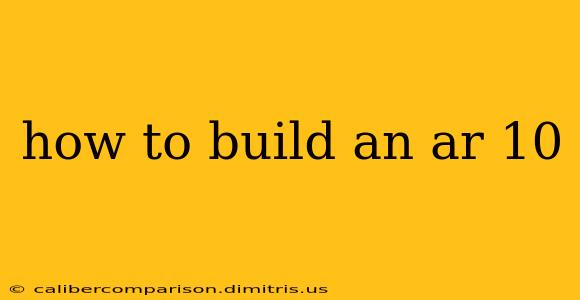Building an AR-10 rifle can be a rewarding experience, allowing for customization and a deeper understanding of your firearm. However, it's crucial to approach this project responsibly and legally. This guide provides a comprehensive overview of the process, from selecting components to final assembly. Always prioritize safety and adhere to all applicable federal, state, and local laws and regulations.
I. Planning Your AR-10 Build: Choosing the Right Components
Before you begin assembling your AR-10, meticulous planning is essential. This phase involves selecting compatible components that meet your specific needs and budget. Consider these key factors:
A. Choosing a Lower Receiver: The Foundation of Your Build
The lower receiver is the serialized part of your AR-10, regulated by the Bureau of Alcohol, Tobacco, Firearms and Explosives (ATF). You can purchase a stripped lower receiver or one that's already partially assembled. Ensure it's compatible with the caliber you've chosen (e.g., .308 Winchester, 6.5 Creedmoor). Thoroughly research different manufacturers and their reputations for quality and reliability.
B. Upper Receiver Selection: Matching Caliber and Features
The upper receiver houses the barrel, bolt carrier group, and charging handle. It must be compatible with your chosen lower receiver and caliber. Consider features like forward assist, dust cover, and rail systems. Different manufacturers offer various levels of quality and features, influencing both cost and performance.
C. Barrel Selection: Accuracy and Caliber Considerations
The barrel is a critical component influencing accuracy, velocity, and overall performance. Consider barrel length, twist rate (crucial for bullet stability), and profile (influencing weight and heat dissipation). Research different barrel materials (stainless steel, chrome moly) and manufacturers known for high-quality barrels. The choice of barrel will heavily influence the overall performance of your AR-10.
D. Bolt Carrier Group (BCG): The Heart of the Action
The BCG is responsible for cycling the action, and choosing a high-quality BCG is non-negotiable. Ensure it's compatible with your chosen caliber and upper receiver. Look for manufacturers with a strong track record of reliability and durability. A faulty BCG can lead to malfunctions and even dangerous situations.
E. Other Essential Components: A Detailed Checklist
Beyond the core components, several other parts are essential:
- Charging Handle: Choose a comfortable and reliable charging handle.
- Gas System: Select the appropriate gas system length (mid-length, carbine-length) for your barrel length.
- Gas Tube: Connects the gas block to the gas key on the BCG.
- Handguard/Rail System: Allows for mounting accessories like optics, lights, and grips.
- Buttstock: Choose a stock that fits your body type and shooting style.
- Grip: Select a comfortable and ergonomic pistol grip.
- Trigger: The trigger group significantly impacts the rifle's shooting characteristics. Upgrading the trigger is a common modification.
- Magazines: High-quality magazines are essential for reliable feeding.
- Sights or Optic: Choose sights or an optic that suits your needs and budget.
II. Assembling Your AR-10: A Step-by-Step Guide
This section provides a general outline of the assembly process. Always consult the specific instructions provided by the manufacturers of your chosen components. Improper assembly can lead to malfunctions and safety hazards.
A. Lower Receiver Assembly: Installing the Trigger Group and Other Components
Begin by installing the trigger group and hammer pin(s) into the lower receiver. Then, install the safety selector, grip, and buffer tube.
B. Upper Receiver Assembly: Attaching the Barrel and Bolt Carrier Group
Attach the barrel nut to the barrel extension. Install the barrel into the upper receiver. Then, install the bolt carrier group into the upper receiver.
C. Completing the Assembly: Joining the Upper and Lower Receivers
Carefully align the upper and lower receivers and attach them. Ensure the components are correctly seated. Finally, install any remaining parts like the handguard, sights, or optics.
III. Testing and Verification: Ensuring Your AR-10 Functions Correctly
After assembly, it's crucial to test your AR-10 at a safe shooting range. Begin with a thorough function check, ensuring smooth cycling and feeding. Always wear appropriate safety gear, including eye and ear protection. Start with a limited number of rounds to identify any immediate issues.
IV. Legal Considerations: Understanding AR-10 Regulations
Building an AR-10 is subject to various federal, state, and local laws and regulations. Before starting your build, research and fully understand these regulations. Failure to comply with all applicable laws can result in serious penalties.
This guide provides a general overview. Always consult with experienced firearm builders, gunsmiths, or your local firearms authority for specific advice and guidance. Safe and responsible gun ownership is paramount.

